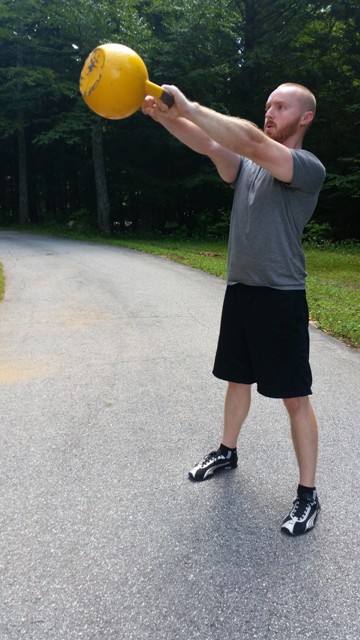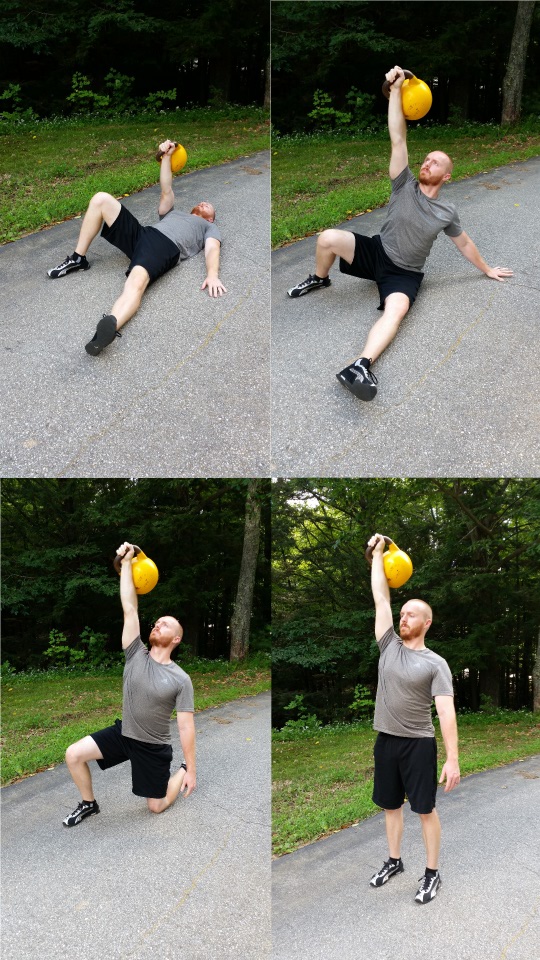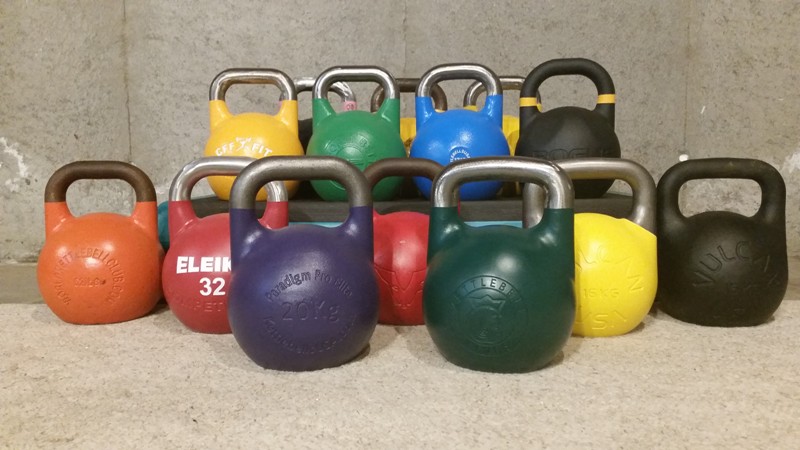Are Kettlebells Dangerous? Should You Avoid Kettlebells? Answers to 10 Common Kettlebell Objections and Criticisms

In this post, I’ll be answering ten common kettlebell criticisms and objections, mostly centered around the topic of so-called “kettlebell dangers.”
QUESTION:
Hi John,
Thanks for your newsletter. I enjoy it.
Recently you reviewed some of the kettlebells available on the market.
[Note from John: here it is: Kettlebell Review]
But do you advocate training with them at all?
I read this scathing blog today: http://www.rdlfitness.com/avoid-kettlebells/
What do you think?
-Moshe
ANSWER: The short answer is yes, I absolutely recommend and advocate for kettlebell training. I think they are a valuable tool for anyone involved in fitness or strength training.
Now, are they necessary? No. The best thing since sliced bread? Not really. But are they useful? Absolutely. And when they’re used in the right way, kettlebells can yield outstanding benefits, some of which cannot be easily provided with most other fitness tools. You can do some things with a kettlebell that you just can’t do with other traditional strength training tools. I mean, try doing a swing with a barbell. Or, better yet, the kettlebell swingblade exercise.
Now, some would say that kettlebells are just a fad, trend, or gimmick and will soon fade into antiquity. But here’s the thing. Kettlebells have been rising in popularity here in the United States for almost two decades. And they originated in Russia centuries before that. Undoubtedly, many new fads, trends, and gimmicks will be introduced here in the USA. But I think it’s safe to say that if we’re going on two decades without slowing down, kettlebells are here to stay. And I think that’s a very good thing.
Kettlebells are in a class of their own. Of course, not everyone feels this way. So, in today’s post, I’m going to answer some of the common criticisms and objections to kettlebell training.
Note: just to toot my own horn for reference, I’ve been using kettlebells for over ten years and have been a CST-certified Kettlebell Specialist for four years. I’m not a kettlebell training expert or guru. Just someone who uses them along with many other excellent tools.
 Objection #1: Explosive kettlebell lifting is dangerous for your back, neck, shoulders, etc.
Objection #1: Explosive kettlebell lifting is dangerous for your back, neck, shoulders, etc.
Not according to this study, which found the opposite to be true. The study was done on adults “from occupations with a high prevalence of reported musculoskeletal pain symptoms…Participants were randomly assigned to training–consisting of ballistic full-body kettlebell exercise 3 times per week for 8 weeks–or a control group.”
And get this: the group that trained with kettlebells saw significant reductions in pain in all areas tested (i.e. neck, shoulders, lower back). And these were adults with a median age of 44 years who had been suffering from from chronic pain. Let that sink in for a moment. So, they weren’t exactly testing college Jocks. Pretty cool, right?
Their conclusion?
Worksite intervention using kettlebell training reduces pain in the neck/shoulders and low back and improves muscle strength of the low back among adults from occupations with a high prevalence of reported musculoskeletal pain symptoms. – The guys in white coats here
Now, it’s true that kettlebell training or “explosive lifting” (a term I disdain), can be dangerous if it is done improperly, as can any other form of exercise. But when kettlebell training is performed mindfully, by trained individuals who have attained appropriate skill and conditioning levels, it is very safe.
You see, all training runs on a spectrum of risk to benefits. So, it’s true that increasing an exercise’s speed (e.g. training “explosively”) increases the risk of injury and other problems. But that risk can be greatly managed through proper instruction, progression, and other key aspects of safe training that any good coach will implement.
Suffice to say, proper training, whether it’s with a kettlebell, clubbell, barbell, or a sandbag greatly reduces the risk of injury. Furthermore, when speed naturally comes as a byproduct of good technique, it’s usually been developed quite safely.
Objection #2: You should avoid kettlebells because they’re mostly used for overhead exercises.
I’m not sure how this idea originated because:
a) there are hundreds of basic kettlebell exercises and most of them are not performed overhead, and
b) being strong overhead is pretty important, and much preferable to being weak overhead.
But some people think that all overhead strength training exercises are too risky and lead to shoulder problems (e.g. impingement). My response is that overhead exercises are risky when you don’t have the mobility (i.e. range of motion) and stability (i.e. strength) required to perform them properly, which is more common than you might think due to misuse, disuse, and abuse. So, training must be tailored to the individual.
In the same breath, when it comes to training overhead exercises, I think the kettlebell represents a safer, more functional tool than barbells and dumbbells because of its offset center of mass. This allows the kettlebell lifter to “move around” the weight instead of the more restricted, linear movement pattern that a barbell or dumbbell requires. For example, when you press a kettlebell overhead, your shoulder naturally rotates. This cannot be accomplished with a barbell and tends to be awkward with a dumbbell.
But the bottom line is that regardless of which tool you use, when you do have the mobility and stability, and otherwise have the functional ability to perform the exercises properly, the risk is very low – even with overhead exercises.
Objection #3: Kettlebells encourage and are used for bad exercises and positions.
Kettlebells don’t actually encourage anything. They’re lifeless metal objects that don’t do much besides take up space. But I digress. In all seriousness, there are no bad exercises. Some exercises are misused (i.e. wrong exercise for the job), and many are performed poorly (i.e. bad technique). But there are no bad exercises – only poor implementation and execution of exercises.
It’s true that many kettlebell exercises involve postures and movements that deviate from conventional exercise positions (e.g. standing, sitting, or laying down with a neutral spine). And I see that as one of the main benefits they offer – to effectively train these many movements and positions that conventional tools cannot train as well.

Now, some people would say that an exercise like the Turkish Get-up should never be performed because it takes the spine out of neutral position under load. To that I would say, the TGU, when performed properly, involves a neutral spine throughout the full range of motion of the exercise. This is accomplished through proper shoulder and hip movement. Any deviation from a neutral spine (which is not a fixed position, per se, but a range) is very slight. So, anyone who cannot perform a TGU without a neutral spine probably lacks either the knowledge on how to perform it properly or lacks the shoulder or hip mobility that’s necessary (i.e. a very common problem for our sedentary culture).
And by the way, life and sport doesn’t happen in perfectly controlled positions. We are asymmetrical creatures who bend, tilt, and twist just as much as we move forward/backward, up/down, and side to side. Life is very dynamic, even chaotic. And there is much value in training outside of those “perfect posture” ranges and linear movement patterns. So, exercises like the Turkish Get-up or the Windmill are not bad exercises or positions. But they can be higher risks if trained mindlessly, with poor technique, through pain, with inadequate preparation or poor programming, among other things.
Objection #4: You can’t get big and strong with kettlebells.
You’re kidding, right? Tell that to the very strong and muscular kettlebell athletes out there! Seriously, whoever makes this claim probably doesn’t understand much about strength training or muscle building. And they definitely haven’t met many kettlebell athletes. What they probably mean is that you won’t win any pro bodybuilding or powerlifting competitions with kettlebells. And they’re (mostly) right. Of course, that’s not why most people train with kettlebells. So, I think it’s a non-issue.
The truth is you can get very big and strong without lifting heavy weights – whether using barbells, dumbbells, kettlebells, or any other implement, including your own body weight. Your body only knows resistance – not where that resistance is coming from (e.g. dumbbell vs kettlebell). So, assuming you adhere to the main principles and best strategies for strength and muscle building, kettlebells can certainly do the job.
Now, to maximize one’s strength and hypertrophy, and approach your genetic limits (e.g. professional bodybuilding or powerlifting), heavy weightlifting will be necessary. But most people don’t even come close to their genetic potential or need to use ultra-heavy weights to achieve their strength and muscle building goals.
Keep in mind that if you want to get moderately strong with kettlebells, you’re going to need some moderate weights in the 24-32kg range or higher. So, that 8 kg pink kettlebell probably won’t be heavy enough to pack slabs of muscle on your frame. But you knew that already, didn’t you?

Objection #5: Kettlebells place excessive stress on specific areas of the body (e.g. bad for your wrists, shoulders, etc.).
This is true (to a degree) of all training tools and exercise modalities – barbells, dumbbells, kettlebells, clubbells, etc. You can’t get around it. It just comes with the territory with any fitness or athletic activity. So, what do you do? You compensate for the over-specializations and over-compensations that occur from training. And regardless, you make sure your training is balanced no matter what tools you’re using.
For example, kettlebell training produces a little more wear and tear on your elbows and wrists than most other strength training tools. So, you’ll want to make sure that you’re warming up those joints before every session with mobility exercises like these. And whenever you’re done training and your forearms are totally pumped, you’ll want to release that tension with targeted stretching, vibration training, and compensatory movement.
You’ll also want to train antagonistic muscle groups and opposite movement patterns, cycle your training, and take time off from kettlebells periodically. Again, these are all things that any good coach or program will include.
Objection #6: Kettlebells require a lot of balance, coordination, agility, and extra “stabilizer work,” which limits the prime movers and undermines overall physical development.
Come again? I really don’t understand how training your balance, coordination, agility, AND your strength, endurance and cardio-respiratory function, among many other conditioning attributes “undermines overall physical development.”
You are only as strong as your weakest link. You can have the strongest prime movers in the world and it isn’t going to mean a hill of beans if you’re weak, injured, or dysfunctional elsewhere. Furthermore, if your fitness isn’t practical, functional, or able to work in “real life,” which requires many distinct skills and abilities, then you are the one who is limited – not the exercise or tool you’re using.
And can we stop trying to isolate and compartmentalize the body? I get it. In any given strength exercise, we’ve got prime movers and stabilizers. At least, that’s one way of looking at it, which I would argue is outdated because it’s based on body parts and muscle groups instead of movement patterns and kinetic chains (see Anatomy Trains by Myers). But when it comes to movement and performance in real life (e.g. vocations, athletics, etc.), it all works together. And if you don’t train it all together, you’re probably going to end up with an imbalanced body.
Now, it’s true that too much stabilizer work limits the training stimulus of the prime movers. I mean, if you’re trying to do barbell back squats while whistling and balancing a pitcher of water on your head and standing on an exercise ball that’s balanced atop a kettlebell handle – you probably won’t maximize the contraction of your larger muscle groups (i.e. prime movers). But no one does anything crazy like that. There’s a time for emphasizing and focusing on your prime movers. And there’s a time for emphasizing your stabilizers. And I’d say it’s a good thing when you can emphasize them both, which is what happens with most kettlebell exercises.
Objection #7: There are safer, more efficient ways to exercise.
Of course, there are safer ways to exercise! And if safety is your #1 goal, then activities like walking carefully, playing mini-golf, and doing water aerobics with a personal flotation device may be preferable to swinging kettlebells. But I digress.
It’s the idea of “more efficient ways to exercise” that I take issue with because kettlebells are one of the best fitness tools for training efficiently (among others). You see, kettlebell training is really effective for a few training goals (e.g. increasing strength endurance being a prime example), and it’s pretty effective for almost everything else (e.g. fat loss, muscle building, improving conditioning, etc.). As mentioned before, you can accomplish a lot with a good kettlebell training program (e.g. strength, endurance, agility, body transformation, etc.). And you can get both a cardiovascular and strength training workout done in minutes if you know what you’re doing. That’s pretty efficient, if you ask me.
Objection #8: Kettlebell training is too complex, especially for beginners.
Proper instruction is the key. Think about it. No one in their right mind would think they could learn Olympic weightlifting without a coach (i.e. unless you’re a Crossfitter, but I jest…) because it’s a technical skill that requires instruction, practice, and feedback to learn and perform safely. The same is true of kettlebell training. And fortunately, learning kettlebell exercises is much simpler than learning the barbell Olympic lifts, especially when you use the right progressions.

So, you don’t start someone off with a double kettlebell snatch or the long-cycle clean and jerk, which are both highly technical exercises. You start with a basic rock-it drill or the hard-style two-handed swing or the goblet squat, all of which almost anyone who is healthy enough to exercise can learn in minutes. Then after those exercises have become comfortable, you practice an exercise that is just a little more sophisticated (e.g. clean).
With kettlebell training, many rudimentary exercises naturally lead into more sophisticated exercises, making progression natural and speedy. When you train in this way, you’re not learning entirely new exercises so much as you’re refining and/or adding new elements to exercises you’ve already learned. So, you’ll get to the point where even an exercise like the double kettlebell snatch is manageable.
Objection #9: You could hit yourself or drop one on your pinky toe.
Yep. That’s a distinct possibility. So, is dropping a barbell or a dumbbell or any other fitness tool. Or, being struck by lightning, eaten by sharks, or abducted by aliens. And it does happen. I’ve seen the Youtube videos. And I read on the Internet that everything on the Internet is true.
I will say this, though. I’ve been training with kettlebells for the last 10+ years, have participated in kettlebell classes with dozens of others (i.e. swinging kettlebells right next to one another), and trained many people in their usage, and I have never witnessed a kettlebell accident. Obviously, it happens. It must. But in my experience, it’s very rare. And it’s probably because smart training goes a long way. And that’s the only way that I advocate training – wisely.
Objection #10: Kettlebells are just plain dangerous – period.
Well, not everyone agrees with that assertion. Like Scott Iardella, for example, who is a certified strength and conditioning specialist, a certified RKC-II kettlebell coach, and also has a master degree in physical therapy. He says that kettlebells “are a tremendous tool in actually preventing injury” and that they are “extremely safe…provided you get the proper instruction.” (source) And therein lies the key. Are you noticing a theme?
Now, in all seriousness, life is dangerous. And training can be dangerous, too, regardless of the tools or methods you use. Weightlifters, runners, yogis, and all sorts of other people get hurt from training, all the time. But that doesn’t mean those activities are inherently dangerous. Risky, maybe. But there’s a big difference between risk and danger. And smart athletes and fitness enthusiasts become masters of managing risk.
Note: One of those is the risk of a fearful mindset negatively effecting your performance. So, if you think that kettlebells are dangerous, you probably shouldn’t be using them!
Final Words
Before we wrap up, I’d like to expand upon what Scott said because I agree that kettlebells can be an effective injury prevention tool.
In a study for the Journal of Strength and Conditioning Research, back specialist, Dr. Stuart McGill and his team concluded that “quantitative analysis provides an insight into why many individuals credit kettlebell swings with restoring and enhancing back health and function, although a few find that they irritate tissues.” In other words, kettlebell training is therapeutic and restorative for some people, and problematic for others.
Of course, more research is needed to gain additional clarity on this subject. And we’ll just have to speculate until that happens. So, if I had to venture a guess, it would be that kettlebell training is more likely to be problematic for people who:
a) have a history of medical problems (e.g. back pain) or another pre-existing condition that would predispose them to injury (i.e. that requires rehabilitation prior to vigorous physical exercise)
b) don’t receive proper instruction in kettlebell training and/or don’t use proper form, programming, progressions, etc.
c) ignore common warning signs and pain signals
Said another way, I think that kettlebell training is most problematic for people who are doing it wrong.
Note: Becca Borawsi Jenkins wrote up an explanation of Dr. McGill’s study here.
The Bottom Line
So, are kettlebells dangerous? Well, if you don’t know what you’re doing, they can be. But if you do know what you’re doing, the risks can be greatly minimized.
Obviously, anyone who claims that kettlebells are the only way to get fit, strong, ripped, or athletic (etc.) is wrong, and they probably drank too much Kool-Aid. In the same vein, anyone who says that kettlebells are the best way to achieve any and all fitness goals is wrong, too. Kettlebells are just one tool in the toolbox that offer some unique advantages and disadvantages.
When used properly, kettlebells can yield outstanding benefits, which is why I wholeheartedly recommend training with them if you’re at all involved with strength training, or fitness, in general.
So, if you’d like to get into kettlebell training, here are some of the best kettlebells currently available:
14 Kettlebells Compared: The Complete Kettlebell Review
And here are a couple of the best kettlebell workout programs I’ve ever used:
Beginners start here: The Official Kettlebell Foundation.
For Experienced Kettlebell Trainees: TACFIT Kettlebell Spetsnaz.
If you found this article helpful, please share it with your friends:
.jpg)
![]()
Health-First Fitness Coach
P.S. If you liked this post, then please signup for the newsletter, or follow me on Facebook or Twitter for daily updates and other interesting info.
P.P.S. Photo credit: 1.
Related Posts
14 Minutes of Continuous Kettlebell Practice
Interview with Greg Mihovich (about kettlebell training and more)
References
Beardsley, Chris, and Contreras, Bret. “The Role of Kettlebells in Strength and Conditioning: A Review of the Literature.” Strength & Conditioning Journal: June 2014 – Volume 36 – Issue 3 – p 64–70.
Jay, K, et al. “Kettlebell training for musculoskeletal and cardiovascular health: A randomized controlled trial.” Scandinavian journal of Work, Environmental, and Health 37(3): 196-203, 2011.
McGill, Stuart M, and Leigh W. Marshall. “Kettlebell swing, snatch, and bottoms-up carry: Back and hip muscle activation, motion, and low back loads.” Journal of Strength and Conditioning Research 26(1): 16-27, 2012.
Note: Chris Beardsley has a superb summary of the latest kettlebell research here.


Do you anything about TACFIT Kettlebell Powerformance program? How does that differ from the two you recommended?
Hi Leon, It’s not as comprehensive as the others, but it’s another good program from Sonnon.
Tell my niece that, she spent two years unable to walk and had to have major back surgery but still has back issues after training with CrossFit and doing the kettle all swing ! I would refer you to ‘sports science’which outlawed any ballistic exercise years ago let alone with weights! David Downes the coach to the Australian Power Lifting team was the first to make me aware of this back in the early eighties! To see CrossFit come along and think they ‘invented’ these excercises is laughable they were all just too young and haven’t got the proper qualifications because if they did they would be aware of weighted ballistic excercies being a huge no no!!